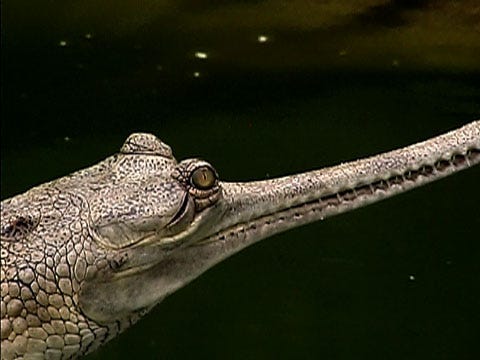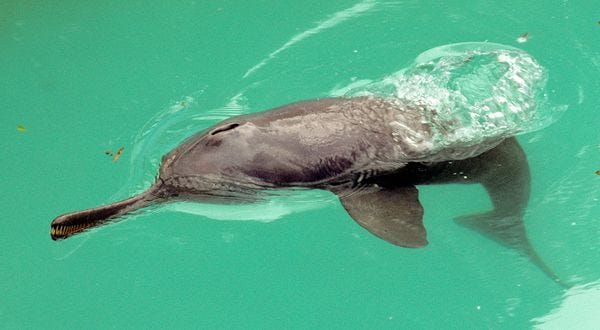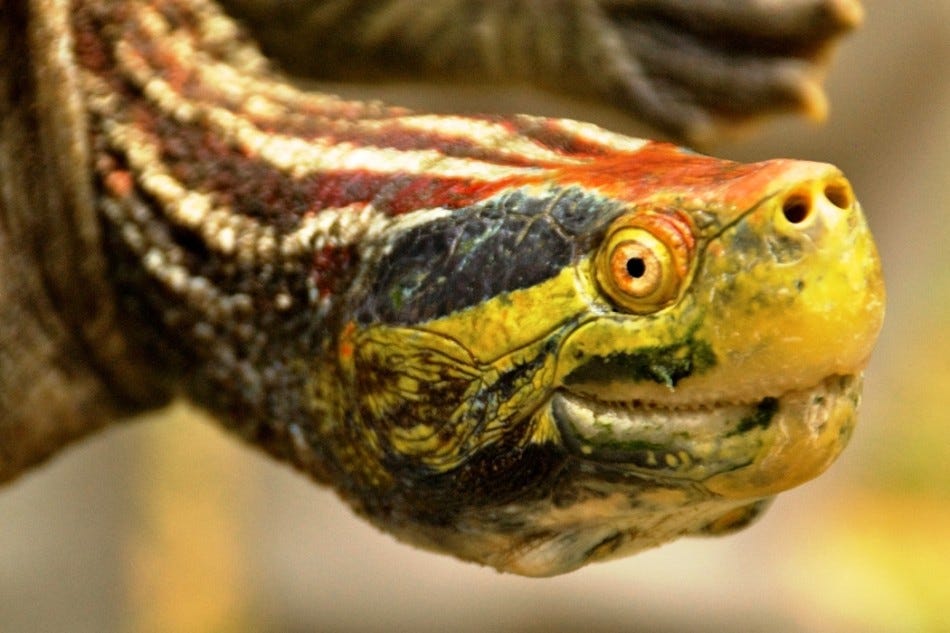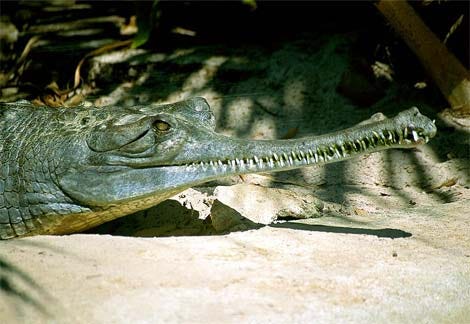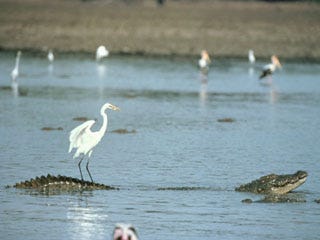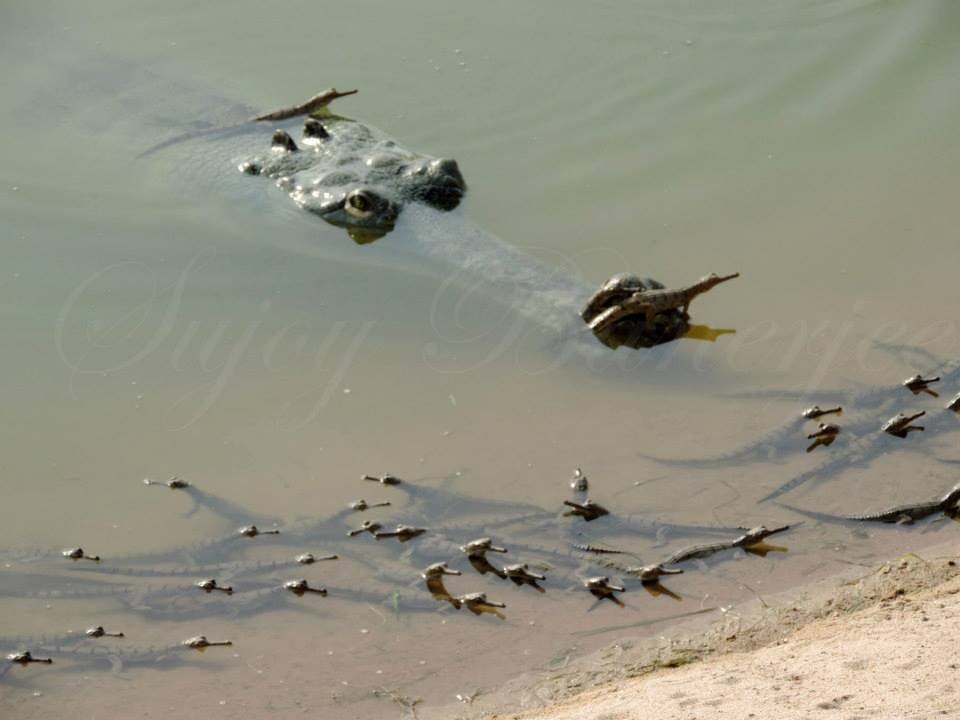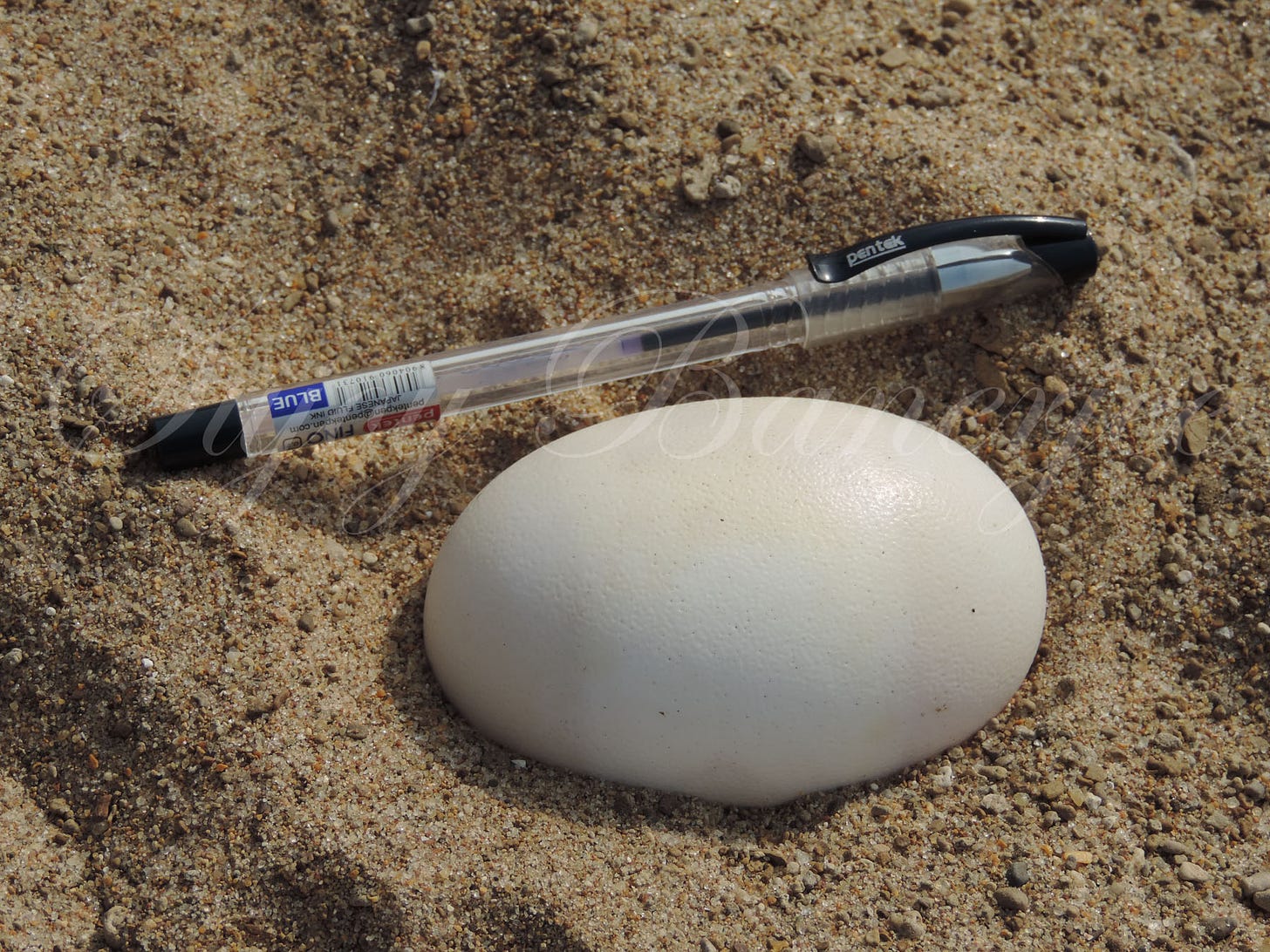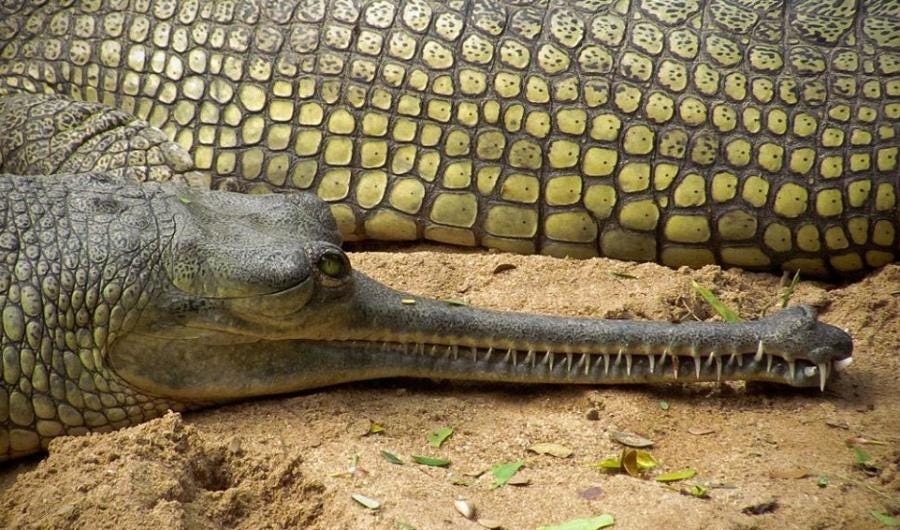China’s Wolong Nature Reserve has Giant Pandas, but India’s Chambal Wildlife Sanctuary has Gharials & Gangetic Dolphins
By Jordan Schaul | National Geographic | July 2013
As humans continue to encroach on waterways and wild lands and develop them to the extent they can, some species may vanish with or without our attempts to conserve them. With that said, we continue to fail at keeping illegal poachers at bay; we continue to reproduce exponentially; and we also fail to mitigate the effects of climate change, among other things.
We have been doing these things with great proficiency for a long time to the detriment of the environment. Indeed, we have damaged nature at the expense of non-human species and their respective ecosystems.
Fortunately, however, there is a great reason to have hope because of a few committed and passionate people who believe that getting species off that “Critically Endangered” list is not only possible but conceivable in our lifetimes, for many species already imperiled.
“Fortunately, however, there is a great reason to have hope because of a few committed and passionate people who believe that getting species off that “Critically Endangered” list is not only possible but conceivable in our lifetimes, for many species already imperiled.”
When Deputy Conservator of Forests of the Department of Forests for the Indian State of Uttar Pradesh, Sujoy Banerjee graciously invited me and Baiju Raj, administrative wildlife biologist of the Wildlife SOS-managed Agra Bear Rescue Facility (ABRF), to his office, I thought we might talk about bears, birds, and lions literally.
After all, Sujoy is the brain behind the designing and development of the upcoming Lion Safari, a priority project of the Government of Uttar Pradesh. He has worked as the Director of Species Conservation for the World Wildlife Fund- India. There, he oversaw tiger, elephant, and rhino conservation projects for the entire country.
He also has his jurisdiction over the largest sloth bear holding facility in the world—the Agra Bear Rescue Facility—because, the facility is located inside the protected Soor Sarovar Bird Sanctuary, for which the Deputy also serves as the managing administrator and project head.
I wasn’t aware though, that the Deputy also heads up the National Chambal Wildlife Sanctuary from the Division’s Agra-based Headquarters, in addition to managing four bird sanctuaries including the Soor Sarovar Bird Sanctuary.
The National Chambal Sanctuary is the only tri-state sanctuary in India and extends, namely over portions of Uttar Pradesh, Madhya Pradesh, and Rajasthan. It is managed by deputies of the respective states. Sujoy Banerjee is responsible for the management of the Uttar Pradesh portion of the sanctuary.
The National Chambal Sanctuary is home to three species virtually on the brink of extinction, gharials (Gavialis gangeticus) or the long-snouted crocodile, Gangetic dolphins (Platanista gangetica), and the Red-Crowned Roof Turtle. These three keystone species are listed as “Critically Endangered” in the World Conservation Union’s (IUCN) Red List and as well are listed in Schedule – I, the highest level of protection afforded India’s Wildlife Protection Act of 1972. The Gangetic river dolphins are the big draw, but gharials, I suspect are a close second!
The South Asian dolphin is a freshwater riverine cetacean comprised of two subspecies. The nominate subspecies Platanista gangetica gangetica, is the Ganges river dolphin native to waterways of Bangladesh, India, and Nepal, and specifically the Ganges and Brahmaputra Rivers and their tributaries.
In addition, out of India’s 26 species of turtles found in India, the Chambal is home to eight species— three are listed in Schedule – I of the Wildlife Protection Act of India, including the hyper-herbivorous and Critically Endangered species of Batagur turtle—the red-crowned roof turtle.
The other turtles listed in Schedule – I are the Indian narrow-headed softshell, and the three-striped roof turtle—another Batagur spp. All six Batagur (Kachuga) species are endemic to South and Southeast Asia and extremely imperiled.
Other riverine chelonians include Indian flapshell turtles, softshell turtles, and tent turtles.
The National Chambal Sanctuary is also listed as an Important Bird Area (IBA). A wide range of resident and migratory bird species can be found along the Chambal River, where it flows through the protected sanctuary.
These include the “Vulnerable” (IUCN RED LIST) species: Indian skimmers, sarus cranes, Pallas’s fish eagles, and Indian coursers and “Near Threatened” (IUCN RED LIST) species: lesser flamingos and pallid harriers.
Striped Hyena, smooth-coated otters, black-bellied terns, and black-necked storks are also included among the riverine assemblage of Indian fauna. Each themself would probably be high-profile draws were in not for the dolphins and crocodiles in the sanctuary along with other threatened and endangered species in the National Chambal Sanctuary.
The sanctuary also proudly boasts of two primate species (Hanuman langurs and Rhesus macaques), two species of mongooses, sambar, nilgai, blackbuck, Indian gazelles, and monitor lizards. Several lesser profile mammals and birds and miscellaneous herpetofauna other than varanid lizards can also be found in the protected area.
It is the desire to save the gharial and continuation of the Wildlife Division’s famed conservation breeding program for the fish-eating crocodilian that helps to keep the Chambal River Ecosystem pristine. Heavy protection and intense management of the Sanctuary for the benefit of one keystone species, benefit all.
In 2010, the establishment of a National Tri-State Chambal Sanctuary Management and Coordination Committee for gharial conservation at the Central Government level for the National Chambal Sanctuary was announced. The Committee is responsible for developing protection programs for gharial and gharial habitat conservation through further management and science initiatives.
Adult & Baby Gharials – Ganges – BBC Film
Crawling Gharials – Wildlife Films India
China may have giant pandas, but India has gharials! I’m not joking.
“China may have giant pandas, but India has gharials! I’m not joking.”
The gharial program is in many ways very similar to the giant panda conservation program based at Wolong’s National Nature Reserve, near Chengdu, China.
The giant panda is often thought of as the “cute poster child” for the “Critically Endangered.” I find the gharial to be just as stunning a creature, as it is specialized much like the giant panda.
“The giant panda is often thought of as the “cute poster child” for the “Critically Endangered.” I find the gharial to be just as stunning a creature, as it is specialized much like the giant panda.
Though it is absolutely harmless to humans and cattle, it suffers from a perception of being harmful because of its similarity to the broader snout crocodiles.
The Wolong Giant Panda Nature Reserve is near Chengdu, the capital of Sichuan Province in Southwest China. The preserve for 150 captive and wild giant pandas is the largest of its kind and a few hour’s drive from Chengdu. There are only approximately 1500 giant panda in the world, 80% of which are found in the bamboo forests of Sichuan Province.
Here in New Delhi, I’m similarly a few hours drive to the Chambal River and the National Chambal Sanctuary (AKA National Chambal Gharial Wildlife Sanctuary). Similar to the Wolong preserve, which serves as a research and captive breeding hub for “Critically Endangered” giant pandas, as well as a refuge for wild individuals, the National Chambal Sanctuary serves as a research and captive breeding hub for “Critically Endangered” gharials, as well as a refuge for wild gharials.
Most people, I suspect, typically avoid anything that even looks like a crocodile, even though the gharial is hyper-piscivorous—in other words, it really only eats fish and occasionally small mammals, but like the narrator of Nat Geo video above asserts, “the gharial has a perception problem,” or what I, perhaps, erroneously call an image problem.
“Most people, I suspect, typically avoid anything that even looks like a crocodile, even though the gharial is hyper-piscivorous—in other words, it really only eats fish and occasionally small mammals, but like the narrator of Nat Geo video above asserts, “the gharial has a perception problem,” or what I, perhaps, erroneously call an image problem.”
The narrow snout permits quick agile movements that cut down on the impact of water when the gharials are fishing.
Herpetophiles and herpetologists alike make trips all the way to India, just to visit the National Chambal Sanctuary, and those aquatic mammophiles, seeking river dolphins probably find the gharials just as interesting, when they arrive.
The Chambal also offers sightings of mugger crocodiles, which share the deep rivers and bask on its banks alongside the gharials. Muggers, incidentally have the widest snout of any living crocodilian.
No longer syntopic or even sympatric (overlapping in niche or range), with the great Indopacific crocodile, the extant gharial population only occurs in 2% of its historic range. Chambal, coincidentally, holds half of the world’s gharial population.
The Croc Bank (The Madras Crocodile Bank Trust & Centre for Herpetology) in Southern India, is one of the most prominent captive breeding and research centres for crocodilians in the world and was the first to breed gharials in captivity in the late 1980s and they introduced a Headstart program in Chambal in collaboration with the Wildlife Division. Some hatcheries were also set up by the Uttar Pradesh and Madhya Pradesh Forests Departments.
Recently, a team from the St. Augustine Alligator Farm in Florida, another prominent center for captive breeding and research on crocodilians (i.e. caiman, crocodiles, and alligators) toured the Chambal National Sanctuary with Deputy Banerjee. St. Augustine Alligator Farm is home to the Association of Zoo and Aquariums’ Crocodilian Biology and Captive Management School and a diverse collection of herpetiles and a wading bird rookery.
Although Nepal has 3 protected areas for Gharials and Indian nine, only three of India’s rivers are known breeding habitats for the “Critically Endangered” gharial.
The gharial (gavial) is quite an interesting creature. It looks just like the man-eating estuarine crocodile from a distance in terms of body length and size. But gharials, the only sexual dimorphic crocodilian species in the world, can be recognized by gender-specific attributes. The males boast a bulbous ghara (pot) on the end of their snout or rostrum. The ghara is suspected to modify the males’ courtship vocalizations.
The Forest Department of Uttar Pradesh is the only agency to have ever conducted regular census studies on the gharial population in the Chambal. The census figures reveal that five years ago there were 307 gharials in the Uttar Pradesh portion of the National Chambal Sanctuary and the number increased to 674 by 2012.
Deputy Banerjee said, “mass mortality of about 125 gharials had taken place in 2007-08 which resulted in plummeting of gharial populations to abysmally low levels.”
According to the Deputy, 758 adult crocodiles have been counted in 2013 in the National Chambal Sanctuary, which he attributes to intensive protection efforts and effective control of illegal mining and illegal fishing activities by the Uttar Pradesh Forest Department.
“According to the Deputy, 758 adult crocodiles have been counted in 2013 in the National Chambal Sanctuary, which he attributes to intensive protection efforts and effective control of illegal mining and illegal fishing activities by the Uttar Pradesh Forest Department.”
When I asked what challenges are facing gharials in the Chambal, the Deputy said “there are two direct threats to Gharials—Illegal sand mining on the banks of the Chambal river, and; illegal fishing.
Mining not only destroys their habitat, but it causes disturbance in their basking areas and basking behavior, and removal of sand from the banks of the Chambal river destroys nesting sites of gharials.
With regard to fishing, he said that “gharials get caught in the illegal nets and end up either drowning or the fishermen break their snouts to free them from the nets leaving them to die a slow, painful death.
According to the Deputy, strict enforcement against illegal sand mining and illegal fishing has shown astounding results.
Protection of gharial nests is another key activity that helps secure the future of gharial breeding. He said this is accomplished by fixing a 2 ft X 2 ft wire mesh and securing it on four sides with long iron staves. This protects the eggs from jackals, dogs, and other animals who would otherwise dig up the nests to predate on the eggs.”
He went on to say that his field staff has successfully protected 55 nests of the “Critically Endangered” gharials, each of which house clutches of 35-40 eggs. The nests protected by the Forest Department are only a part of the total nesting of gharials, which would be more than 200 by a conservative estimate.
This conservation effort of the Forest Department of Uttar Pradesh comes in light of the
fact that it was estimated in 2006 that there were less than 200 breeding adult gharials in the world. Now there would be well more than 200 egg-laying females in the Uttar Pradesh portion of the National Chambal Sanctuary.
“This conservation effort of the Forest Department of Uttar Pradesh comes in the face of the fact that it was estimated in 2006 that there were less than 200 breeding adult gharials in the world. Now there would be well more than 200 egg-laying females in the Uttar Pradesh portion of the National Chambal Sanctuary.”
Finally, Deputy Banerjee said, “We expect to see as many 3000 or more hatchlings finding their way from their nests to the Chambal River. Their survival depends more on the intensity of flooding in the river; the width of the river is not even 50 meters at the time of hatching but is more than a kilometer wide with swift-flowing water during the rainy season. Hence, many of the hatchlings eventually do not survive beyond the rainy season. But even if a small portion of this number eventually makes it to adulthood, it would be a reasonable addition to the gharial population.”
ABOUT NATIONAL GEOGRAPHIC SOCIETY
The National Geographic Society is a global nonprofit organization that uses the power of science, exploration, education and storytelling to illuminate and protect the wonder of our world. Since 1888, National Geographic has pushed the boundaries of exploration, investing in bold people and transformative ideas, providing more than 14,000 grants for work across all seven continents, reaching 3 million students each year through education offerings, and engaging audiences around the globe through signature experiences, stories and content. To learn more, visit www.nationalgeographic.org or follow us on Instagram, Twitter and Facebook.
MEET THE AUTHOR
Jordan Carlton SchaulWith training in wildlife ecology, conservation medicine, and comparative psychology, Dr. Schaul's contributions to Nat Geo Voices have covered a range of environmental and social topics. He draws particular attention to the plight of imperiled species highlighting issues at the juncture or nexus of sorta situ wildlife conservation and applied animal welfare. Sorta situ conservation practices are comprised of scientific management and stewardship of animal populations ex situ (in captivity / 'in human care') and in situ (free-ranging / 'in nature'). He also has a background in behavior management and training of companion animals and captive wildlife and conservation marketing and digital publicity. Jordan has shared interviews with colleagues and public figures, as well as editorial news content. In addition, he has posted narratives describing his own work, which include the following examples: • Restoration of wood bison to the Interior of Alaska (As Animal Curator at Alaska Wildlife Conservation Center and courtesy professor at the University of Alaska) • Rehabilitation of orphaned sloth bears exploited for tourists in South Asia (As executive consultant 'in-residence' at the Agra Bear Rescue Center managed by Wildlife SOS) • Censusing small wild cat (e.g. ocelot and margay) populations in the montane cloud forests of Costa Rica for popular publications with 'The Cat Whisperer' Mieshelle Nagelschneider • Evaluating the impact of ecotourism on marine mammal population stability and welfare off the coast of Mexico's Sea of Cortez (With Boston University's marine science program) Jordan was a director on boards of non-profit wildlife conservation organizations serving nations in Africa, North and South America and Southeast Asia. He is also a consultant to a human-wildlife conflict mitigation organization in the Pacific Northwest. Following animal curatorships in Alaska and California, he served as a charter board member of a zoo advocacy and outreach organization and later as its executive director. Jordan was a member of the Communication and Education Commission of the International Union for the Conservation of Nature (CEC-IUCN) and the Bear Specialist Group of the IUCN Species Survival Commission (BSG-SSC-IUCN). He has served on the advisory council of the National Wildlife Humane Society and in service to the Bear Taxon Advisory Group of the Association of Zoos and Aquariums (AZA Bear TAG). In addition, he was an ex officio member of the council of the International Association for Bear Research and Management.



